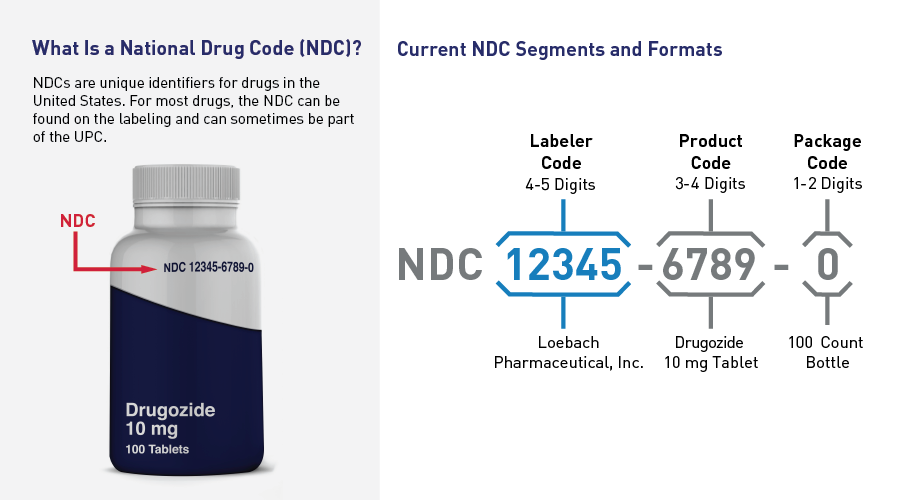FDA Proposes to Revise the National Drug Code (NDC) Format From 10-digits to 12-Digits. Here’s What 503Bs Should Know.
The FDA announced a new proposal to revise the National Drug Code (NDC) format and Drug Label Barcode Requirements
On July 22, 2022, the FDA proposed a new rule to update the NDC, or National Drug Code, format from a 10-digit code to a 12-digit code over the next five years citing that the NDC will eventually run out of 5-digit labeler codes within the next 10 to 15 years.
FDA NDC Proposal Summary:
The FDA is running out of 5-digit NDCs and proposed a solution for the future.
FDA proposes a specific length for each segment to create a unified format.
The labeler code would be 6 digits, the product code would be 4 digits, and the package code would be 2 digits (a 6-4-2 format).
The new NDC format would be 12-digits, not 10-digits as it is currently.
The proposal allows a 3-year transition period to help ease the burden of costs, and to ensure stakeholders can handle both 10-digit and 12-digit labels.
The effective date of the rule would be five years after the final ruling’s publication.
Stakeholders will take on the cost of implementing the new format.
Submit your comments to help the FDA make their decision on the proposed ruling.
History of National Drug Code Rule-making
The NDC, or National Drug Code, is an FDA standard for uniquely defining drugs marketed in the United States and contains 10 digits, as described in 21 CFR 207.33(b). The 10-digit code currently consists of three segments: labeler code, product code, and package code.
According to the FDA, in 2016, they published the Registration and Listing Final Rule, which recognized the FDA would eventually run out of the 5-digit labeler codes in the future and established two additional NDC configurations: 6-3-2 and 6-4-1, for a total of five possible configurations (including the 10-digit NDC configurations).
In 2018 discussions began via public hearings, where the FDA outlined several formatting proposals. After receiving comments on the four options proposed, comments submitted afterward favored the adoption of a single standardized format and establishing a date when it would be required for 10-digit code systems to be in place —many commenters advocated for a 10-year delay.
The FDA’s Proposal
The FDA states “Under the proposed rule, the NDC would remain a 3-segment numerical code consisting of the labeler code, the product code, and the package code. However, we are proposing to establish a uniform length for each segment to create a uniform format. Specifically, we are proposing that the labeler code would be 6 digits in length, the product code would be 4 digits in length, and the package code would be 2 digits in length (a 6-4-2 format).”
Commenters also suggested a variety of other solutions that you can read here.
The FDA proposes to delay the final rule's effective date for a five-year period after the publication date in the Federal Register to provide stakeholders sufficient time to update systems and handle the new 12-digit format. If the FDA runs out of 5-digit codes, the effective date may result in stakeholders having less time to update systems and handle the new format.
NDC Segments Now and in the Proposed Future
Today, the first NDC segment is the labeler code and is a unique 4- or 5-digit code that identifies the drug's manufacturer, repacker, relabeler, or private label distribution. The second segment is the product code, a 3- or 4-digit number that identifies a specific active ingredient, strength, and dosage. And the third segment is the package code, a 1-to-2-digit number that identifies package types and sizes.
The current segments total a 10-digit code.
In the proposal, the FDA is set to rule on a 12-digit format NDC by adding leading zeros to the labeler code, product code, and/or package code segments to produce the 6-4-2 format. The figure from the FDA shows the proposed National Drug Code change.
Additionally, the FDA anticipates that the HIPAA standards and other code sets that currently require a 10-digit native NDC to be converted to 11-digit NDCs and would likely need to be updated in some manner. Read more here about proposed HIPAA conversion examples.
Why Change is Necessary
The FDA claims that within the next 10 to 15 years, the NDC formatting will need to accommodate longer NDCs because of the new labelers coming into the U.S. markets and because the NDC will soon run out of the 5-digit numbers.
“In 2016, when FDA published the final rule Requirements for Foreign and Domestic Establishment Registration and Listing for Human Drugs, Including Drugs That Are Regulated Under a Biologics License Application, and Animal Drugs” (the Registration and Listing Final Rule), the Agency stated that when it runs out of 5-digit labeler codes, it will begin assigning 6-digit labeler codes (81 FR 60169 at 60187, August 31, 2016). As a result, under existing regulations, FDA would add 2 new 11-digit NDC formats (6-3-2 and 6-4-1) to accommodate the longer labeler codes”, as stated by the Federal Register.
The Adoption of a Single NDC Format
According to FDA, if the proposed changes are finalized, the standardized format would facilitate the adoption of a single NDC format by all stakeholders. This is seen as a benefit and would eliminate the need to convert NDCs to different standardized formats used by other sectors of the healthcare industry (e.g., healthcare providers and payers) and could reduce potential errors.
The FDA believes adopting a single format may eliminate the need for quality control and validation by stakeholders like payers and prescribers, which is important for insurance coverage and reimbursement claims.
Anticipated Costs to Implement NDC Changes Nationwide
As stated by the FDA, “The Unfunded Mandates Reform Act of 1995 (section 202(a)) requires us to prepare a written statement, which includes an assessment of anticipated costs and benefits, before proposing “any rule that includes any Federal mandate that may result in the expenditure by State, local, and tribal governments, in the aggregate, or by the private sector, of $100,000,000 or more (adjusted annually for inflation) in any one year.” The current threshold after adjustment for inflation is $158 million, using the most current (2020) Implicit Price Deflator for the Gross Domestic Product. This proposed rule would not result in an expenditure in any year that meets or exceeds this amount.”
The Federal Register shows the summary of quantified costs of the proposed rule.
Transition and Costs to Stakeholders
The cost to make these changes includes “one-time” costs, according to the FDA, for updating system software, training, updating labels, and understanding the new ruling. Because federal entities do not fund the transition, stakeholders including 503B outsourcing facilities will spend their own money making these internal changes.
The FDA is proposing to allow for a 3-year transition period following the effective date to help mitigate potential costs with reprinting product labels and for stakeholders to ensure systems can handle both 10-digits and 12-digits NDCs. During the 3-year period the FDA will not object to stakeholders using the 10-digit number.
The effective date of the rule is five years after the final rule’s publication.
Effective Dates and Requirements
On the final rule's effective date, the FDA will start assigning new NDCs in the 12-digit uniformed format.
The existing 10-digit NDCs assigned by the FDA before the effective date will be required to be converted to the new 12-digit format. As a result, each stakeholder must have systems in place to handle the new, uniform 12-digit NDC on the final rule's effective date.
Once the final ruling is established, the FDA proposes to delay the effective date for five years following its publication to allow stakeholders the time to implement and develop their systems.
In addition, the FDA is proposing to allow a 3-year transition period after the effective date of the final ruling for stakeholders using 10-digit NDCs to begin updating their labeling to replace the 10-digit NDCs with the new 12-digit NDCs.
Submit Your Comments To FDA
The FDA encourages public comments to help make decisions on the proposed ruling. Either electronic or written comments on the proposed rule must be submitted by November 22, 2022. Submit comments on information collection issues under the Paperwork Reduction Act of 1995 (PRA) by August 24, 2022. Late submissions will not be considered. Submit comments to Regulations.gov by November 22, 2022 11:50pm EST.
Does Your Facility Produce Quality Preparations?
If you’re ready to bring quality to the center of your compounding operations, consultants at Restore Health Consulting LLC can help you design a robust quality management system to promote patient safety and regulatory compliance.
Resources:
Are you prepared for a major industry change to the national drug code (NDC) number?
Federal Register: Revising the National Drug Code Format and Drug Label Barcode Requirements
Proposed Rule on Revising the National Drug Code Format
Revising the National Drug Code Format and Drug Label Barcode Requirements (Comments)
Summary of the Unfunded Mandates Reform Act
Two Numbers From 10 to 12 – What a Difference It Can Make!
Disclaimer:
The information provided on this website does not, and is not intended to, constitute legal advice; instead, all information, content, and materials available on this site are for general informational purposes only. Information on this website may not constitute the most up-to-date legal or other information. Readers of this website should contact their attorney to obtain advice with respect to any particular legal matter.


